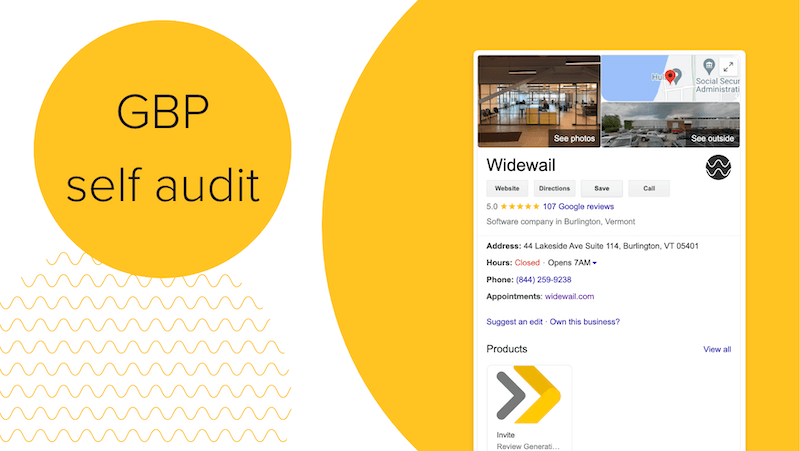-
Products
TechnologyManaged Services
- Resources
- Pricing
- Company
If your business’ GBP (formerly known as Google My Business) is due for a Google Business Profile optimization check-up, here are some key do’s and don’ts.

Don’t kid yourself: your Google Business Profile can always be improved. Whether your business’ GBP (formerly known as Google My Business) has never undergone an audit or the practice is part of your quarterly checklist, here are some of the key do’s and don’t’s of auditing your own account.
First, let’s make sure we’re all on the same page.
An audit, in general terms, is a detailed inspection of an organization and its accounts. Usually, you’re looking for ways to improve. An audit of your GBP is often performed with the hopes of determining how to make your business rank higher on Google. High-level, when looking at your profile assess what additions you should make to your GBP, identify a new review generation target, and features that can be improved.
If you’re busy, you can just plug your business into Widewail’s GBP Performance Tool to quickly get an idea of where you’re at.
Looking externally isn’t the only way to go, however. It’s possible to audit your own Google Business Profile, and this guide will teach you to do so strategically and objectively.
To start, consider and write down your goals for your Google Business Profile optimization efforts. Do you want to get more traffic? More leads? Do you want to rank higher on Google? Do you want a higher average star rating?
Based on your answers to these questions, you’ll know which of the upcoming sections to focus on.
Section 1–Accuracy– will help you double-check that the basic information on your GBP page is correct and up-to-date. It will ensure that potential customers who see your page will be able to contact you. For service businesses, we’ll encourage you set up a “service area” location, as opposed to providing a specific address.
Desirability will focus on enhancing the aspects of your GBP that will make your page more desirable to prospects. You will ask yourself if your customers are going to trust your page’s information and want to reach out. Focusing on reviews and responses as well as your search engine competition, this section will offer strategies and resources to get more reviews and rank higher.
The final section– Uniqueness– applies to businesses who have unlocked or want to incorporate the special features of Google Business Profile. Does your restaurant’s reservation system work accurately? How effective are your page’s posts? After this segment, you’ll be confident that the special features on your GBP will attract and secure customers.
A Google page with inaccurate information will lose you customers. No question. If your address is incorrect or misleading, your customers will literally be unable to find you. If your phone number is outdated, you’ll never be able to answer their calls. If your business’ description suggests that you’re a restaurant but you’re really a bar, then you’ll have hungry customers leaving upset (and likely to write a bad review).
Even if you’re a GBP pro, it’s okay to double (and triple) check these basic features of your page. Catching one mistake or updating any information that has changed since the pandemic will be a key differentiator for your business.
.png?width=502&name=GBP%20panel%20example%20honey%20road%20(1).png)
TIP: You want your Q&A to serve as a hub of information for your prospects. If no one has asked any useful questions on your page, you can ask them yourself. Here’s how to get a robust Q&A section in two easy steps. 1) Switch your browser to incognito mode and ask 10-20 FAQs. 2) Go back to a regular browser and make sure you’re signed back into your business account. From this account, answer the questions you wrote. Responses should have a blue store icon with a checkmark on top.
For businesses that provide a service on-site as opposed to at a storefront, such as plumbers, pest control, roofing, solar installation, or mobile pet groomers, it’s ideal to build a “service area GBP.” Don’t use a personal residential address for your business, instead, simply leave it blank. Add the areas you work within to the “add service area” field.
Are you an electrician based in the Burlington, Vermont area who is willing to travel far and wide for your customers? Make that clear by adding all the towns and counties you serve. The general rule is to limit the areas to within 2 hours of your home base.
-1.png?width=300&name=GBP%20example%201%20(1)-1.png)
.png?width=300&name=GBP%20example%202%20(1).png)
Notice the difference. The lefthand business lists only an address, while JLS Electrical notes the “Areas served.” Clicking this phrase takes you to a window that includes every town served by the company.
.png?width=212&name=GBP%20service%20areas%20example%20(1).png)
As part of your self-audit, determine whether your GBP should list only an address or include the areas served feature. If using a service area, click into the list to make sure it lists all of the locations your business is willing to travel to.
Your audit is more than just a nod to the fact that your contact details are up-to-date. The reason you’re auditing your GBP is because you want to rank higher. Right? Your ranking on Google compared to your competitors has a lot to do with your reviews and your rating. The latest wisdom suggests review content is the #2 ranking factor for your business.
But how many reviews do you actually need? The answer depends on the account optimization and review performance of your competition. You want to be more desirable than your competitors. More specifically, you want to have more reviews and a higher rating than every competitor. This distinction is important because there is not a single review number all businesses need to strive for in order to be successful. In Solar, 150 reviews will likely be competitive, whereas a car dealership likely needs 2,000+ to stand out. The composition of your local market adds further complexity. The point being, to determine an appropriate review performance target for your business you’ll have to do some research.
To perform a quick competitive analysis, take your business’ primary category + city and do a search, find your ranking, and identify the review volume of the top competitors. Identifying the top review volume numbers for competitive businesses in the area will determine a target review volume the business should achieve to compete. Once you have a volume goal in mind, determine how many reviews you’ll need to get to rank competitively. (Bonus: we break this process down in an earlier post)
Your review frequency is important, as is how recent your reviews are. Ask yourself:
In their 2020 Local Consumer Review Survey, Brightlocal found that 73% of consumers only care about the reviews written during the previous month. This stat suggests that your business needs to generate new, positive reviews each month to remain desirable to your prospects. A good experience you provided a customer two years ago is great, but what can your prospects expect tomorrow? Businesses evolve just as people do and your reviews should keep up.
Widewail encourages businesses to ask every customer for a review. Yes, every single one. We have determined that review requests should have a roughly 10% conversion rate, so your target number of reviews to receive monthly should be 10% of your monthly transaction volume (target = 0.1 x # of customers served in a month). This performance can vary based upon the specific qualities of your industry. On the high end, some Widewail clients convert as much as 35% of requests into reviews.
Generating a higher volume of reviews can help you raise your average star rating. You should consider your competitors’ average ratings and aim to beat those, but generally speaking, an ideal rating is in the 4.6-5.0 range.
Next to consider is review response. Brightlocal determined that 89% of consumers are 'highly' or 'fairly' likely to use a business that responds to all of its online reviews. In your audit, ask:
TIP: Mix up your responses by expressing gratitude for positive reviews in unique ways. Here are some examples. “This feedback is appreciated by our entire team here at [business]” or “Thank you for sharing these kind words!”
Responding to reviews is key. According to HBR, businesses that respond to reviews see 12% more review volume and a star rating increase of 0.12-stars. On a more human level, these improvements are simply a result of the customer having more motivation to leave feedback because they know it will be read and engaged with. Everybody prefers to have their voice heard.
Optimizing your GBP requires some goal-setting and competitive analysis. In order to ensure that your business gets the most out of its page, make sure you establish targets, stay on top of review generation and response, and check performance metrics against your goals periodically.
Once you’ve made your plan to improve your reviews and rating, it’s time to take advantage of all that Google offers you. This section covers how you can work your unique selling proposition into the GMB.
If your business has a point of view or a unique approach to doing business (for us it’s Trust Marketing), double-check you’ve communicated this point in multiple locations on your profile.
Does your book store include a coffee shop? Make it clear on your page. Does your car dealership have an in-house nail salon? Flaunt that. Make your page stand out in more ways than one.
Improve your GBP by incorporating posts. This is another way to engage with your customers beyond including unique photos and featuring great reviews. Google lays out all you need to know about posts here.
It is essential that your basic information is correct and up-to-date. That’s your first step. Beyond this, you have some creative license to find ways to achieve your GBP goals. Any further questions? We love talking reviews and GBP strategy and we’re here to help so feel free to reach out.
To get a head start or fresh perspective on your GBP audit, pop your business information into Widewail’s GBP Performance Tool for a free, immediate report.
I’m a writer, philosopher, climber, mountain biker, and a fried-egg enthusiast. Before joining Widewail as a Review Response Specialist, I attended Middlebury College and studied Philosophy and Art History. I grew up in Michigan, but I fell in love with Vermont while in school.
Bite-sized, to-the-point, trend-driven local marketing stories and tactics.
Automated Review Generation
Video Testimonial Generation

Maintain Accurate Listings

Private Surveys
Review Response Managed Services
Social Media Engagement Services
©Widewail 2025.
U3GM Blog Post Comments